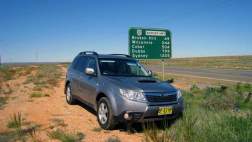The new SUV boasts better economy, quality and high-tech 4WD features gleaned from Land Rover. Last seen on Australian Ford dealer lots as a new car in 2006, the new Explorer has been re-launched in the US with a splash - including a Facebook reveal and public unveilings across North America - with the option of the 176kW Spanish-built two-litre EcoBoost turbocharged DOHC 16-valve direct-injection alloy four-cylinder on a two-wheel drive model.
Ford US is claiming a 30 per cent increase in fuel efficiency over the current US V6 from a close relation to the powerplant destined for the Australian Ford Falcon, although Ford Australia has not yet revealed the source engine plant for its upcoming Falcon EcoBoost model.
Ford say the 2011 Explorer will be exported to more than 90 countries after it goes into production later this year, but the Ford Australia order books won't feature it as it is not engineered for right-hand drive, says Ford spokeswoman Sinead McAlary.
"We have no plans to sell the new Explorer in Australia because it hasn't been engineered for right-hand drive, it's left-hand drive only. "They have not engineered it for right-hand drive… the 90 countries must all be left-hand drive or can take those vehicles in a right-hand drive market," she says.
McAlary says it has not even thought about the possibility of the Explorer returning to Australia. "It's not even on our radar because it's LHD only - plus we have Territory so it's not on the radar at all," she says.
Ford has spent more than $400 million upgrading its Chicago plant to build the new Explorer, adding 1200 new jobs in the process. The other powerplant on offer in the new Explorer is an Ohio-built 216kW 3.5-litre DOHC alloy V6, which can run front or all-wheel drivetrains.
Ford is also claiming a world-first safety feature - second-row inflatable rear belts, which spread impact forces across more than five times the surface area than conventional seat belts, which the company says reduces pressure on the chest and better controlling head and neck motion.
The new SUV model - now a monocoque body structure instead of the old body on ladder frame - also boasts blind-spot warning system, tyre pressure monitoring, electric power steering, twin variable cams, a six-speed automatic, a fast engine warm-up and aggressive deceleration fuel shutoff to improve fuel use, aside from the inclusion of the EcoBoost four-cylinder.
Ford is using the same line in the US as it is here - it will deliver the power of a naturally-aspirated V6 thanks to turbocharging and direct injection - with some aerodynamic aids to help reduce wind resistance as well. It will also be hauling a bit less weight, thanks to higher-tensile steel in the body, an aluminium bonnet and other weight-saving parts in the engine bay.
"The all-new Explorer will give a huge universe of existing and prospective customers the capability they expect and the luxury and convenience they want, all combined with the fuel economy they need," says Mark Fields, Ford president of The Americas.
"Explorer owners told us they want capability with convenience, and improved fuel economy without compromised performance," Fields says. "We believe we’ve hit the mark with the next-generation Explorer. It has the potential to change perceptions of what a modern SUV is all about."
Offroad system
The new Explorer SUV has replaced the traditional transfer case with a version of Land Rover's terrain response system for its 4WD model - chief nameplate engineer Jim Holland, a former Land Rover engineer, says the new system takes the mystery out of 4WD-ing.
"We saw the opportunity to eliminate a compromise by adding an intuitive and efficient terrain management system that can demystify four-wheel-drive control and enable the driver to properly match 4WD traction to the situations and road conditions they encounter," he says.
The system was tested by vehicle testing engineer Todd Hoevener, who will soon be in Australia for a new SUV development program. "With Explorer ready to deliver best-in-class fuel efficiency and customer-empowering capabilities, among its many other attributes, I'm off to Australia to develop a new SUV for Asia Pacific region markets," he says.
McAlary refuses to elaborate on what Hoevener is working on, saying only that the Australian arm of the company had developed a number of vehicles for the region that had not been for sale in Australia.
The Explorer development team says it has aimed at quality and refinement, employing laser measuring systems and an air leakage test that employs a thermal imaging camera to spot hot air leaks from within the vehicle.
Ford Explorer's Australian sales
2006 239
2005 430
2004 891
2003 1467
2002 1869
2001 1387
2000 1498
1999 1812
1998 3509
1997 3823
1996 605







.jpg)


.jpg)
.jpg)








Comments